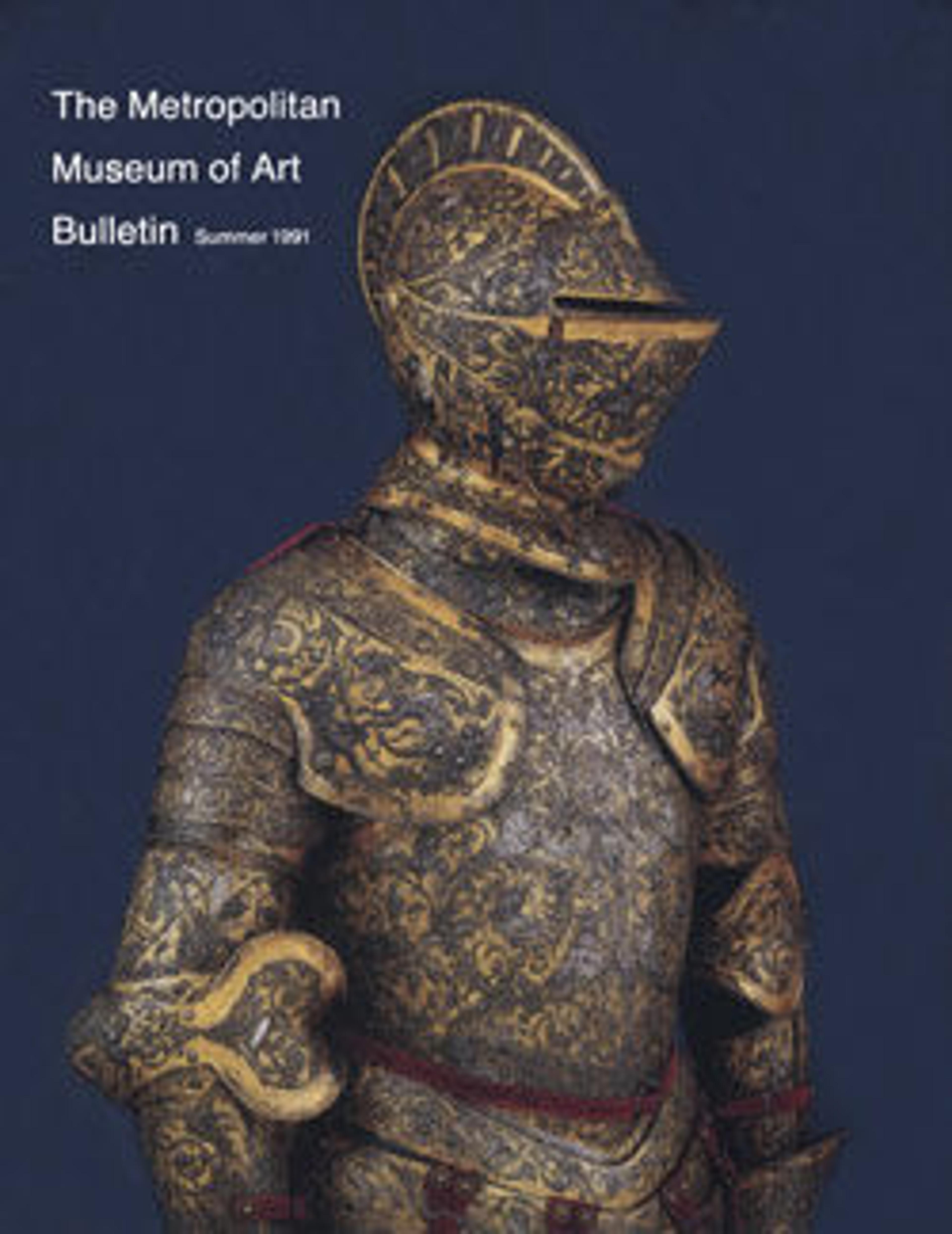Halberd of Prince Karl Eusebius of Liechtenstein (1611–1684)
The halberd head––consisting of an axe blade with strongly concave cutting edge, a wide double-edged thrusting blade with strong mid-ridge, and a down-curved apical beak––is almost completely covered with etched decoration. On one side of the axe blade is etched the arms of the Princes Liechtenstein, and on the other an oval medallion with the emblem of a hammer-wielding hand striking a pointed anvil, the personal device of Carl Eusebius (1611–1684), Prince of the Empire and Regent of the House of Liechtenstein, and the inscription VIRTUTE ELUDITUR ICTUS ("Through virtue he eludes the blow"). On the thrusting blade is the monogram of Prince Carl Eusebius, and on the beak is the date 1632. Both the armorial shield and the monograms are surmounted by the cap of state of a prince of the Empire. The angles between the three blades––axe spike, and beak––are decoratively cusped; the socket is square in cross section and fastened to the four-sided shaft by four side straps.
The arms etched on one side of the axe blade show the family arms of Liechtenstein: per fess, or and gules, on the inescutcheon; the shield itself is quartered with an inserted point: in 1, barry of or and sable, a crancelin vert in bend overall (Dukedom of Saxony), in 2, gules, a chevron sevenfold spiked or (Czernahora von Boskowitz), in 3, per pale, gules and argent (Dukedom of Troppau), in 4, or, an eagle sable, armed and beaked gules, with a crescent surmounted by a cross argent on its breast (Dukedom of Silesia), and in the point, azure, a huntinghorn or (Dukedom Jägerndorf). These arms reflect the complicated family history and the complexity of territorial titles of the Princes of Liechtenstein (see Siebermachers Grosses Wappenbuch; Die Fürsten des Heiligen Römischen Reiches, A–L, vol. I, part III, setion 3A, pp. 138–40, pls. 166–68). The Princes Liechtenstein are an ancient Austrian family; their ancestral castle (now ruined) is near Vienna. From the thirteenth through sixteenth centuries, they assembled vast holdings in Bohemia, Moravia, and Silesia (now Czech Republic, Slovakia, and Poland). Prince Carl (died 1627), the father of Prince Carl Eusebius whose monogram is etched on this halberd, had added the Silesian Dukedom of Troppau in 1613, and that of Jägerndorf in 1623. Carl Eusebius's son, Johann Adam Andreas (1656–1712), acquired in 1708 the country of Vaduz, which in 1719 was elevated to the status of a principality by Emperor Charles IV, and which is now the Principality of Liechtenstein.
The arms etched on one side of the axe blade show the family arms of Liechtenstein: per fess, or and gules, on the inescutcheon; the shield itself is quartered with an inserted point: in 1, barry of or and sable, a crancelin vert in bend overall (Dukedom of Saxony), in 2, gules, a chevron sevenfold spiked or (Czernahora von Boskowitz), in 3, per pale, gules and argent (Dukedom of Troppau), in 4, or, an eagle sable, armed and beaked gules, with a crescent surmounted by a cross argent on its breast (Dukedom of Silesia), and in the point, azure, a huntinghorn or (Dukedom Jägerndorf). These arms reflect the complicated family history and the complexity of territorial titles of the Princes of Liechtenstein (see Siebermachers Grosses Wappenbuch; Die Fürsten des Heiligen Römischen Reiches, A–L, vol. I, part III, setion 3A, pp. 138–40, pls. 166–68). The Princes Liechtenstein are an ancient Austrian family; their ancestral castle (now ruined) is near Vienna. From the thirteenth through sixteenth centuries, they assembled vast holdings in Bohemia, Moravia, and Silesia (now Czech Republic, Slovakia, and Poland). Prince Carl (died 1627), the father of Prince Carl Eusebius whose monogram is etched on this halberd, had added the Silesian Dukedom of Troppau in 1613, and that of Jägerndorf in 1623. Carl Eusebius's son, Johann Adam Andreas (1656–1712), acquired in 1708 the country of Vaduz, which in 1719 was elevated to the status of a principality by Emperor Charles IV, and which is now the Principality of Liechtenstein.
Artwork Details
- Title: Halberd of Prince Karl Eusebius of Liechtenstein (1611–1684)
- Date: dated 1632
- Culture: German
- Medium: Steel, gold, wood
- Dimensions: L. 90 5/8 in. (230.17 cm); L. of head (excluding straps) 24 1/2 in. (62.23 cm); W. 11 5/16 in. (28.73 cm); Wt. 7 lb. 7 oz. (3374 g)
- Classification: Shafted Weapons
- Credit Line: Gift of Mrs. Bashford Dean, in memory of Alexander McMillan Welch, 1949
- Object Number: 49.120.13
- Curatorial Department: Arms and Armor
More Artwork
Research Resources
The Met provides unparalleled resources for research and welcomes an international community of students and scholars. The Met's Open Access API is where creators and researchers can connect to the The Met collection. Open Access data and public domain images are available for unrestricted commercial and noncommercial use without permission or fee.
To request images under copyright and other restrictions, please use this Image Request form.
Feedback
We continue to research and examine historical and cultural context for objects in The Met collection. If you have comments or questions about this object record, please complete and submit this form. The Museum looks forward to receiving your comments.
